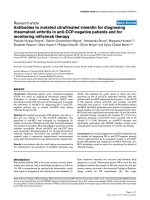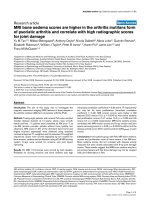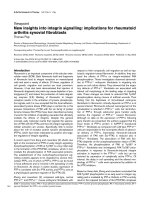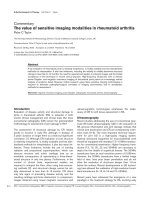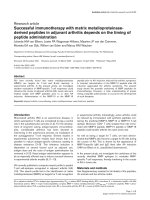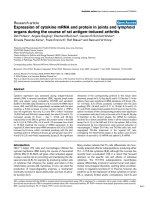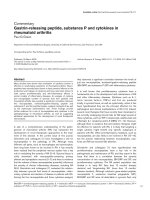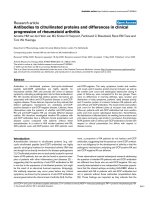Báo cáo y học: "Gastrin-releasing peptide, substance P and cytokines in rheumatoid arthritis Paul G Green" pps
Bạn đang xem bản rút gọn của tài liệu. Xem và tải ngay bản đầy đủ của tài liệu tại đây (38.61 KB, 3 trang )
111
BN/GRP = bombesin/gastrin-releasing peptide; IL = interleukin; MCP-1 = monocyte chemoattractant protein-1; RA = rheumatoid arthritis; SP =
substance P; TNF-α = tumor necrosis factor-α; VIP = vasoactive intestinal polypeptide.
Available online />Abstract
Many studies have shown that modulation of cytokine function is
effective in ameliorating symptoms of rheumatoid arthritis. Neuro-
peptides have recently been shown to have powerful effects on the
production and release of cytokines and have also been shown to
exert potent proinflammatory and anti-inflammatory effects in
animal models of inflammatory diseases. An analysis of cytokine
and neuropeptide content of synovial fluid from patients with
rheumatoid arthritis has revealed a significant correlation between
two neuropeptides, bombesin/gastrin-releasing peptide and
substance P, and the proinflammatory cytokine interleukin-6 as well
as the erythrocyte sedimentation rate. These findings provide
further evidence for a role of neuropeptides and cytokines in the
pathophysiology of rheumatoid arthritis, as well as suggesting
additional approaches for the development of novel therapeutic
interventions.
A lack of a comprehensive understanding of the patho-
genesis of rheumatoid arthritis (RA) has hampered the
development of novel therapeutic approaches to the treat-
ment of this disease. In the current issue of this journal,
Grimsholm and colleagues [1] have investigated a role for
neuropeptides in the pathology of RA. Although many
different cell types, such as macrophages and synoviocytes,
have long been known to be involved in RA, it has recently
been realized that the peripheral nervous system has a key
role in modulating the severity of RA [2–4]. Synovial tissue is
richly innervated with neuropeptide-containing primary
afferent and sympathetic neurons [5–7] and there is evidence
that the release of these neuropeptides powerfully influences
the severity of chronic inflammatory diseases, including RA
[8,9]. Grimsholm and colleagues [1] evaluated the relation-
ship between synovial fluid levels of neuropeptides, inflam-
matory cytokines and duration of disease in patients with RA.
Among the five neuropeptides and three cytokines assayed,
they observed a significant correlation between the levels of
just two neuropeptides, bombesin/gastrin-releasing peptide
(BN/GRP) and substance P (SP) with inflammatory cytokines.
It is well known that proinflammatory cytokines have a
fundamental role in the development and maintenance of RA
and other inflammatory diseases. Cytokines such as IL-1,
tumor necrosis factor-α (TNF-α) and IL-6 are produced
locally in synovial tissue, as well as systemically, where it has
been hypothesized they are the principal effectors for the
pathological and clinical manifestations of RA [10]. Indeed,
several novel therapies that have recently been developed or
are currently undergoing clinical trials for RA target several of
these cytokines, such as TNF-α (etanercept, adalimumab and
infliximab), IL-1 (anakinra) and IL-6 (MRA) [11–14]. However,
although there is evidence that anti-cytokine therapies might
be effective for patients with RA, it is likely that targeting a
single cytokine might benefit only specific subgroups of
patients with RA. Other proinflammatory mediators, such as
neuropeptides, are also likely to be involved in RA [15–19],
but the precise relationship between neuropeptides, cyto-
kines and RA has received little attention.
Grimsholm and colleagues [1] have hypothesized that
proinflammatory neuropeptides have a key role in the
pathogenesis and maintenance of RA, and they report in this
issue that there is a correlation between the synovial
concentration of two neuropeptides, BN/GRP and SP, and
proinflammatory cytokines. The RA patient population was
divided in to ‘early RA’ (less than 12 months’ disease
duration) and ‘longstanding RA’ (more than 12 months’
disease duration). Although calcitonin gene-related peptide,
neuropeptide Y, vasoactive intestinal polypeptide (VIP),
BN/GRP and SP were all detectable in synovial fluid, only
Commentary
Gastrin-releasing peptide, substance P and cytokines in
rheumatoid arthritis
Paul G Green
Department of Oral and Maxillofacial Surgery, University of California San Francisco, San Francisco, CA, USA
Corresponding author: Paul G Green,
Published: 30 March 2005 Arthritis Research & Therapy 2005, 7:111-113 (DOI 10.1186/ar1746)
This article is online at />© 2005 BioMed Central Ltd
See related research by Grimsholm et al., />112
Arthritis Research & Therapy June 2005 Vol 7 No 3 Green
with BN/GRP was there a significant difference between
early and longstanding RA (higher in early RA). SP and
BN/GRP were significantly higher than in healthy controls,
which was consistent with this group’s previous findings [19].
Synovial concentrations of the inflammatory cytokines TNF-α,
IL-6 and monocyte chemoattractant protein-1 (MCP-1) were
detectable in most or all of the patients with RA (no
difference was observed between the two disease groups).
Importantly, further analysis of the data revealed that in
longstanding RA but not in early RA the synovial levels of
BN/GRP were tightly correlated with the synovial levels of
both IL-6 and TNF-α, as well as with serum levels of soluble
TNF receptor 1 (which binds to and neutralizes TNF-α).
Furthermore, there was an inter-relationship between levels of
SP, TNF-α and MCP-1, as well as levels of SP, BN/GRP and
IL-6. The other neuropeptides evaluated were not correlated
with any of the cytokines measured. The authors also noted
that synovial BN/GRP and SP were correlated with a measure
of RA disease state, namely erythrocyte sedimentation rate.
The evidence for the involvement of neuropeptides in
inflammatory diseases has focused predominantly on a
proinflammatory role for SP [15,17], as well as an immuno-
modulatory role for neuropeptide Y [16] and an anti-inflam-
matory role for VIP [8]. The mechanism of action of these
neuropeptides in modulating inflammatory diseases is, at
least in part, due to their ability to affect cytokine production.
For example, SP increases production of the proinflammatory
cytokines TNF-α, IL-6 and IL-1β [20], whereas VIP inhibits the
production of the proinflammatory cytokines TNF-α, IL-6 and
IL-12, and stimulates the production of the anti-inflammatory
cytokines IL-10 and IL-1Ra [21]. The major novel finding by
Grimsholm and colleagues is that synovial BN/GRP, with SP,
is closely associated with IL-6, TNF-α and RA disease
activity. The authors speculate that, in addition to SP,
BN/GRP might stimulate cytokine production from immune
cells to contribute to RA pathology, and that pharmacological
modulation of BN/GRP and/or SP should be considered as
potential new avenues for RA therapy.
The findings for a novel role of BN/GRP in RA, and further
support for a role for SP, are clearly important, but several
questions must be addressed before firm conclusions can be
drawn. A fundamental question is what the causal relation-
ship between BN/GRP and cytokines are; unlike some other
neuropeptides, for which both in vivo and in vitro evidence
has been provided for their ability to produce both pro-
inflammatory and anti-inflammatory cytokines from immune
cells (see above), this has not yet been reported for BN/GRP.
Although the authors tentatively suggest that BN/GRP and
SP might both stimulate cytokine production, BN/GRP levels
were higher in the patients with early RA than in those with
longstanding RA (SP was the same in both groups), which
could indicate that BN/GRP might be involved more in the
development than in the maintenance of RA. Further studies
with selective BN/GRP receptor antagonists, such as
RC-3940-II, in animal models of RA will probably provide
crucial information about the role of this peptide in RA.
There is a clear need for an expansion in the therapeutic
armamentarium for RA given the inadequacy of current
therapies for many patients, and the study by Grimsholm and
colleagues have opened up a potential novel therapeutic
avenue for targeting the underlying pathology not only in RA
but also possibly in other autoimmune diseases.
Competing interests
The author(s) declare that they have no competing interests.
References
1. Grimsholm O, Rantapaa-Dahlqvist S, Forsgren S: Levels of
gastrin-releasing peptide and substance P in synovial fluid
and serum correlate with levels of cytokines in rheumatoid
arthritis. Arthritis Res Ther 2005, 7:R416-R426.
2. Eskandari F, Webster JI, Sternberg EM: Neural immune path-
ways and their connection to inflammatory diseases. Arthritis
Res Ther 2003, 5:251-265.
3. Straub RH, Cutolo M: Involvement of the hypothalamic–pitu-
itary–adrenal/gonadal axis and the peripheral nervous
system in rheumatoid arthritis: viewpoint based on a systemic
pathogenetic role. Arthritis Rheum 2001, 44:493-507.
4. Levine JD, Collier DH, Basbaum AI, Moskowitz MA, Helms CA:
Hypothesis: the nervous system may contribute to the patho-
physiology of rheumatoid arthritis. J Rheumatol 1985, 12:406-
411.
5. Mapp PI, Kidd BL, Gibson SJ, Terry JM, Revell PA, Ibrahim NB,
Blake DR, Polak JM: Substance P-, calcitonin gene-related
peptide- and C-flanking peptide of neuropeptide Y-
immunoreactive fibres are present in normal synovium but
depleted in patients with rheumatoid arthritis. Neuroscience
1990, 37:143-153.
6. Grigg P: Properties of sensory neurons innervating synovial
joints. Cells Tissues Organs 2001, 169:218-225.
7. Miller LE, Justen HP, Scholmerich J, Straub RH: The loss of sym-
pathetic nerve fibers in the synovial tissue of patients with
rheumatoid arthritis is accompanied by increased norepi-
nephrine release from synovial macrophages. FASEB J 2000,
14:2097-2107.
8. Niissalo S, Hukkanen M, Imai S, Tornwall J, Konttinen YT: Neu-
ropeptides in experimental and degenerative arthritis. Ann N
Y Acad Sci 2002, 966:384-399.
9. Cerinic MM, Konttinen Y, Generini S, Cutolo M: Neuropeptides
and steroid hormones in arthritis. Curr Opin Rheumatol 1998,
10:220-235.
10. Odeh M: Role of cytokines in rheumatoid arthritis. Drug News
Perspect 1998, 11:331-341.
11. Mariette X: Emerging biological therapies in rheumatoid arthri-
tis. Joint Bone Spine 2004, 71:470-474.
12. McInnes IB, Gracie JA: Targeting cytokines beyond tumor
necrosis factor-alpha and interleukin-1 in rheumatoid arthritis.
Curr Rheumatol Rep 2004, 6:336-342.
13. Roberts LJ: New drugs for rheumatoid arthritis. N Engl J Med
2004, 351:2659-2661.
14. Klareskog L, van der Heijde D, de Jager JP, Gough A, Kalden J,
Malaise M, Martin Mola E, Pavelka K, Sany J, Settas L, et al.: Ther-
apeutic effect of the combination of etanercept and
methotrexate compared with each treatment alone in patients
with rheumatoid arthritis: double-blind randomised controlled
trial. Lancet 2004, 363:675-681.
15. O’Connor TM, O’Connell J, O’Brien DI, Goode T, Bredin CP,
Shanahan F: The role of substance P in inflammatory disease.
J Cell Physiol 2004, 201:167-180.
16. Bedoui S, Miyake S, Straub RH, von Horsten S, Yamamura T:
More sympathy for autoimmunity with neuropeptide Y?
Trends Immunol 2004, 25:508-512.
17. Keeble JE, Brain SD: A role for substance P in arthritis? Neu-
rosci Lett 2004, 361:176-179.
113
Available online />18. Baerwald CG, Burmester GR, Krause A: Interactions of auto-
nomic nervous, neuroendocrine, and immune systems in
rheumatoid arthritis. Rheum Dis Clin North Am 2000, 26:841-
857.
19. Westermark T, Rantapaa-Dahlqvist S, Wallberg-Jonsson S, Kjorell
U, Forsgren S: Increased content of bombesin/GRP in human
synovial fluid in early arthritis: different pattern compared with
substance P. Clin Exp Rheumatol 2001, 19:715-720.
20. Cuesta MC, Quintero L, Pons H, Suarez-Roca H: Substance P
and calcitonin gene-related peptide increase IL-1 beta, IL-6
and TNF alpha secretion from human peripheral blood
mononuclear cells. Neurochem Int 2002, 40:301-306.
21. Delgado M, Pozo D, Ganea D: The significance of vasoactive
intestinal peptide in immunomodulation. Pharmacol Rev 2004,
56:249-290.
